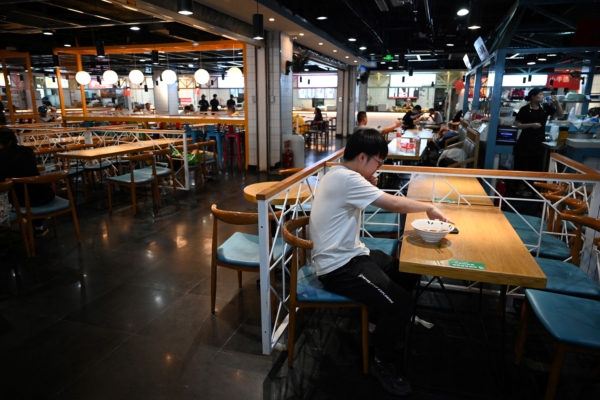China’s economy is facing a multitude of challenges, exacerbated by weak consumer spending, global resistance to Chinese exports, and continued downturn in the real estate market. In response, Beijing rolled out a package of stimulus measures in September, including interest rate cuts and reserve requirement reductions. However, doubts linger among experts whether these measures are sufficient to tackle the economic difficulties at hand.
This autumn, the majority of global banks forecast that China’s economy will fall short of the Communist Party’s established 5% growth target. Over four-fifths of economists surveyed by Bloomberg predicted that China’s gross domestic product growth in 2024 would not reach 5%, with analysts, including those from Bank of America, questioning Beijing’s fiscal and monetary policies.
Currently, China is grappling with mounting pressure from tightening liquidity, with new home prices experiencing their largest drop since 2014 and consumer confidence plunging to its lowest point in a year and a half.
Beijing remains steadfast in pursuing policies that promote economic recovery through high-end manufacturing and exports. Yet, the country’s trade sector is not without risks: while exports have reached their highest level in nearly two years, declining unit prices and increasing vigilance against Beijing’s new wave of cheap goods from abroad pose additional challenges.
There is widespread debate on whether China’s economy might enter a decade-long stagnation similar to Japan’s. Simply put, every sector of China’s economy is facing difficulties.
Following the lifting of COVID restrictions and border reopening in late 2022, there were optimistic forecasts of a surge in consumer spending and economic activity triggered by “revenge shopping,” dining out, and travel. However, against the backdrop of concerns over economic growth, falling property prices, unemployment, and income, this boost was short-lived and quickly dissipated.
As of September, manufacturing activity has remained in contraction since April 2023, with only three months of exception. China holds a 30% share in global manufacturing, with its manufacturing trade surplus representing a significant portion of the world’s GDP and historically growing rapidly at an average rate of 2%. China’s manufacturing output exceeds the combined peak earnings of Japan and Germany during their prime.
Foreign governments worry that they cannot keep up with the pace of China’s manufacturing production growth. When China’s production growth surpasses its own demand or global economic growth, other countries are compelled to scale down or even shut down industries.
Furthermore, China’s industrial subsidy scale is astonishingly large, surpassing that of other countries by far. The Center for Strategic and International Studies (CSIS) found that China devotes around 5% of its GDP to industrial subsidies, which is ten times that of the United States, Brazil, Germany, and Japan combined. In industries like semiconductors, steel, and aluminum, China’s subsidies account for 80% to 90% of global subsidies.
On the other hand, weakened demand in China has also hurt profits for foreign automakers like Stellantis NV and Aston Martin. Global consumer brands, from Starbucks to Estée Lauder, have seen plummeting sales in the Chinese market, as consumers increasingly favor saving money.
An indicator reflecting the fragility of domestic confidence is that this summer, bank loans to the real economy in China saw their first contraction in nineteen years. Local governments, already tight on funds, are burdened with hidden debts, further compounded by the plunge in the property market. Land sale revenues at the local level have been steadily declining at record rates, making it even more challenging to reverse the downward trend in budget expenditures at a time when economic support is desperately needed.
In August, youth unemployment rate rose for the second consecutive month, reaching the highest level this year. This unemployment rate indicator is a newly adopted visual gauge following China’s statistical methodology revision.
For a long time, the Chinese Communist Party has been hesitant to take more proactive measures. However, in September, facing unexpected circumstances, it hastily convened an economic meeting, declaring intentions to achieve the annual economic targets and halt the slide in the real estate market.
Thus far, there has been little evidence of the Communist Party truly exhausting all efforts to revive the economy. Overcoming liquidity tightening and reversing the real estate market slump are both daunting tasks, and the current set of stimulus policies are unlikely to provide a substantial economic boost.
The severe oversupply in housing implies that any real estate stimulus measures will take time to translate into actual construction, if they can be realized at all. As population growth slows and urbanization decelerates, the structural factors driving housing demand are diminishing. Consequently, China may face a prolonged period of weak growth while addressing debt issues, reminiscent of Japan’s “lost decade” following the burst of the real estate and stock market bubbles.
In 2008, in order to combat deflation and address the financial crisis, the Chinese government announced a “bazooka” fiscal policy, releasing 4 trillion yuan for infrastructure investments to stimulate the economy.
According to economists’ estimates cited by the Financial Times, due to the current scale of China’s economy—its GDP being much larger than in 2008—China would need to inject up to 10 trillion yuan over two years to fully achieve economic recovery. Moreover, these funds must flow to households rather than large-scale infrastructure or industrial projects.
The Wall Street Journal also notes that many economists suggest a greater role for consumer spending in China’s economy, calling for significant economic reforms by the Communist Party, such as expanding healthcare and social security networks.
However, these reforms are politically unpalatable for Chinese leaders, as they view Western-style “welfarism” as incompatible with the goal of transforming communist China into a technological giant capable of competing with the United States.
Furthermore, since Chinese households tend to save rather than spend, even efforts to boost consumption through policy measures in the short term have proven to be difficult and impractical. Coupled with uncertainties in Chinese employment and income, these factors are expected to further diminish the effectiveness of stimulus policies.

